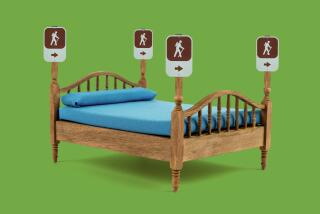A Swell Way to Start
- Share via
The feeling is familiar to anyone who has paddled out on a surfboard for the first time.
“You can’t even lie on the board because it feels like a bar of soap,” Bob Edwards recalled. “The waves seem like Waimea Bay.”
The natives of Oceania first attempted this lunacy centuries ago. Just think of it: surfing is like skiing with the mountain rushing at you, constantly changing size and shape, teetering wildly.
“The whole thing can be terrifying,” Edwards said.
But it can also be savagely fun. And with dozens of surf spots dotting the coastline from Santa Monica to Ventura, there are plenty of opportunities for beginners to test their mettle against the ocean.
That’s where guys like Edwards come in. Decades have passed since he first paddled out and, in the meantime, he has become a well-known Southern California surf coach. In addition to guiding San Diego State to a collegiate championship, he also teaches surfing at his “Kahuna Bob’s Surf School” in Encinitas.
J.D. Drury is another man wise in the ways of the sea, giving lessons out of the Beach Hut in Ventura.
“Some people are serious about learning the sport,” Drury said. “Other times, it’s just a tourist from Germany and he wants to say he came to California and surfed.”
Either way, the experts agree that the first step for any novice is to procure the right equipment.
Longboards are easy to get started on, so look for one that stretches 2 1/2 to 3 feet overhead. It should be thick enough--three inches or so--to float easily. A number of local shops rent boards and wetsuits.
At Horizons West in Santa Monica, boards rent for $15 a day and wetsuits for $10. At Zuma Jay’s in Malibu, the rates are $25 and $8. Drury’s shop is about the same and charges $25 for a 45-minute introductory lesson.
Next comes the beach. Stay away from heavily surfed spots like Malibu’s Surfrider Beach, C Street in Ventura and Rincon at the Santa Barbara County line.
“You’ll only get in the way and get yelled at,” Drury said. “Everybody will get bummed out.”
Try Santa Monica Beach north of the pier; the campgrounds at Emma Wood State Beach in Ventura, which is better for shortboards but breaks regularly and not too big; and a spot called Mondo’s that can be found between the beachfront homes south of Pitus Point. There is also La Conchita beach south of Rincon.
Or simply cruise the coast. A sandy bottom will spare you the misery of what surfers call the “rock dance.” Watch for 10 to 15 minutes to be sure the waves break gently--about knee-to-waist height--and no bigger sets come through.
Most coaches start beginners on the sand. It may look goofy, but so will much of what you do. Remember: Everyone looks like a kook at first.
So practice laying on the board on dry land, then hopping to your feet in one quick motion. You should stand sideways about two-thirds of the way back. If you are right-handed, chances are your right foot will be back. But if you prefer, use the left- or “goofy-foot” stance.
Once you get the feel of hopping up, the best way to begin surfing is to start “inside,” where the waves have already broken, coaches say. Paddle out to chest-high surf.
Start paddling toward the beach when the wave has broken and the white water is about 10 yards away. As soon as the board is swept up, spring to your feet and keep your eyes down.
“The surfboard is a dance floor and the dance floor is moving,” Edwards said. “If you aren’t looking at it, you’re going to fall every time.”
Once you get up and going, look up as you head for land. Your feet should be fairly wide apart and your knees bent.
“It’s all about getting the fundamentals and getting to your feet,” Drury said.
Or, as Edwards put it: “You’re stoked, you’re riding the board.”
As the shore draws near, Edwards suggests that you “stall” the board by shifting your weight to the tail. It’s like stomping on the brakes.
“You want to get off that board before it reaches knee-deep [water],” Edwards said.
It can take several or more attempts to get the knack of paddling, standing and stalling. Get comfortable with these skills before trying to catch real waves, which will require a blend of physical ability and subtle judgment.
As a wave rolls toward shore, its face becomes gradually steeper until it breaks. If you paddle into a face that is too steep you will “pearl,” a misstep that begins with the nose of the board knifing underwater and ends with you draining saltwater from your sinuses.
Start “outside,” where the waves are still relatively gradual and inch your way toward shore until you find the spot where there is enough slope to get going. Once you start catching waves, practice leaning into turns, getting the board to travel parallel to the beach just ahead of the crest.
Through it all, keep your eyes wide open. Watch experienced surfers. And remember that the learning process can be alternately breathtaking and humbling. Surfers spend years, if not decades, honing their skills.
The important thing is to have fun along the way, taking time to enjoy the surroundings.
“Five minutes out in the water and people have the biggest smiles on their faces,” Edwards said. “It’s just something that saltwater does for the psyche.”
If you need a goal, imagine the island surfer that Jack London described in his 1907 collection, “Stories of Hawaii,” a wave-rider standing “calm and superb, poised on the giddy summit, his feet buried in the churning foam, the salt smoke rising to his knees, and all the rest of him in the free air and flashing sunlight, and he is flying through the air, flying forward, flying fast as the surge on which he stands.”
For those who have caught a wave and ridden it down the line, the feeling is familiar.
(BEGIN TEXT OF INFOBOX / INFOGRAPHIC)
Where You Can Catch the Waves
The Top Spots
* Malibu: Hallowed ground where Mickey “Da Cat” Dora once ruled. Summer waves churn across the point with machine-like precision. But the crowds are often big and hungry.
* Overhead: Winter waves that grind more than a quarter-mile out. They may look ridable from shore but they can get real big, real fast.
* Rincon: Ventura County’s answer to Malibu, every bit as clean and perfect but it works best in winter.
Some Solid Surf
* Topanga State Beach: This point breaks right. Rarely as long or clean as Malibu but the crowds are significantly more manageable.
* C Street: A Ventura favorite, the spot encompasses a number of breaks from Fairgrounds south to the pier. Plenty of room to handle crowds.
* Pitas: Houses block the coast here, just past Solimar along Old Highway 101, so you have to hike north from the public beach. Your effort will be rewarded with long, clean rides.
For Beginners
* Sunset Boulevard: Gentle waves make for easy take-offs. Plenty of room for novices to flop around.
* Zuma: Can get steep and fast under certain conditions. But usually small and friendly with miles of uncrowded waves.
* La Conchita: An average beach break with waves that pop up all along the way. Sandy bottom saves wear and tear on the feet.
Source: Times staff and “Surfing California” by Bank Wright.
More to Read
Sign up for The Wild
We’ll help you find the best places to hike, bike and run, as well as the perfect silent spots for meditation and yoga.
You may occasionally receive promotional content from the Los Angeles Times.







